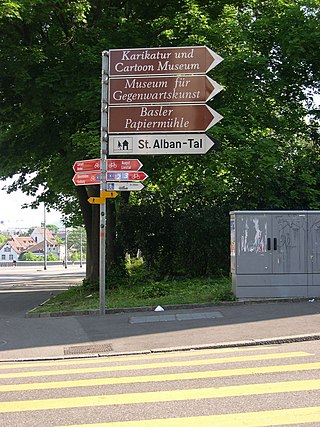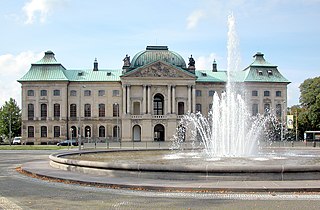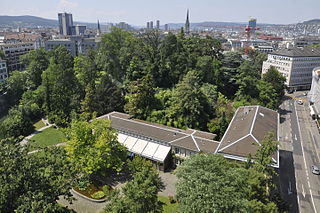
Christian Feest is an Austrian ethnologist and ethnohistorian.
Lukas Vischer (1780-1840) was an amateur artist, traveler, and collector from Basel, Switzerland. During a nine-year residence in Mexico he assembled a notable collection of ancient Mexican sculptures and ceramics. Vischer's collection eventually formed a significant part of the holdings of the Museum of Cultures Basel. It has been called one of the best European collections of pre-Columbian or Mesoamerican artifacts.

The Museum of Asian Art is a part of the Humboldt Forum in Berlin since 2020. Before its relocation it was sited in the neighborhood of the borough of Steglitz-Zehlendorf, Berlin, Germany. It is one of the Berlin State Museums institutions and is funded by the Prussian Cultural Heritage Foundation. It houses some 20,000 Asian artifacts, making it one of the largest museums of ancient Asian art in the world. The museum is located in the same building as the Ethnological Museum of Berlin. The museum houses important collections of Art houses of South, Southeast and Central Asian countries and art from the Indo-Asian cultural area, from the 4th millennium BC to the present. Its geographic reach covers regions in India, Pakistan, Afghanistan, Sri Lanka, Bangladesh, Nepal, the Autonomous Region of Tibet and Xinjiang of the People's Republic of China, the Southeast Asian countries of Myanmar, Thailand, Cambodia, Vietnam, and also the Indonesian Islands or archipelago.

The National Museum of Indonesia is an archeological, historical, ethnological, and geographical museum located in Jalan Medan Merdeka Barat, Central Jakarta, right on the west side of Merdeka Square. Popularly known as the Elephant Museum after the elephant statue in its forecourt. Its broad collections cover all of Indonesia's territory and almost all of its history. The museum has endeavoured to preserve Indonesia's heritage for two centuries.

Georg Christian Thilenius was a German physician and anthropologist who was a native of Soden am Taunus.

The Museum Godeffroy was a museum in Hamburg, Germany, which existed from 1861 to 1885.

The Ethnological Museum of Berlin is one of the Berlin State Museums, the de facto national collection of the Federal Republic of Germany. It is presently located in the Humboldt Forum in Mitte, along with the Museum of Asian Art. The museum holds more than 500,000 objects and is one of the largest and most important collections of works of art and culture from outside Europe in the world. Its highlights include important objects from the Sepik River, Hawaii, the Kingdom of Benin, Cameroon, Congo, Tanzania, China, the Pacific Coast of North America, Mesoamerica, the Andes, as well as one of the first ethnomusicology collections of sound recordings.

The Museum of European Cultures – National Museums in Berlin – Prussian Cultural Heritage Foundation came from the unification of the Europe-Department in the Berlin Museum of Ethnography and the Berlin Museum for Folklore in 1999. The museum focuses on the lived-in world of Europe and European culture contact, predominantly in Germany from the 18th Century until today.

The Basel museums encompass a series of museums in the city of Basel, Switzerland, and the neighboring region. They represent a broad spectrum of collections with a marked concentration in the fine arts and house numerous holdings of international significance. With at least three dozen institutions, not including the local history collections in the surrounding communities, the region offers an extraordinarily high density of museums compared to other metropolitan areas of similar size. They draw some one and a half million visitors annually.

The Museum am Rothenbaum – Kulturen und Künste der Welt, founded in 1879, is today one of the largest museums of ethnology in Europe. The approximately 350,000 objects in the collection are visited every year by about 180,000 visitors. It lies in the Rotherbaum quarter of the Eimsbüttel borough in Hamburg at the Rothenbaumchaussee avenue.

The Dresden Museum of Ethnology contains an ethnographic collection with more than 90,000 artefacts from all parts of the earth. It is part of the Dresden State Art Collections. Founded in 1875, the museum presents continually changing exhibitions in the Japanisches Palais, a Baroque building complex in Dresden, Germany.

The Museum of World Cultures is an ethnological museum in Frankfurt, Germany. Until 2001 it was called the Museum of Ethnology.

The Leipzig Museum of Ethnography is a large ethnographic museum in Leipzig, Germany, also known as the Grassi Museum of Ethnology. Today it is part of the Grassi Museum, an institution which also includes the Museum of Applied Arts and the Museum of Musical Instruments, based in a large building on the Johannisplatz.
Gerd Koch was a German cultural anthropologist best known for his studies on the material culture of Kiribati, Tuvalu and the Santa Cruz Islands in the Pacific. He was associated with the Ethnological Museum of Berlin. His field work was directed to researching and recording the use of artefacts in their indigenous context, to begin to understand these societies.
Robert Bleichsteiner was an Austrian ethnologist.

The Ethnographic Museum of the University of Zurich is the third oldest ethnological museum of Switzerland. Owner of its collections since 1914 is the University of Zurich. The main fields of the museum's activities are the maintenance of the collections, research, teaching and public relations.
Ethnomuseology is the study of museums and museum curation in the context of the culture and cultural traditions of its collections. It is an interdisciplinary field combining museum studies, anthropology, ethnography, and often various fine arts.
Nils Seethaler is a German cultural anthropologist. He researches historical collections of ethnological objects and human remains.












